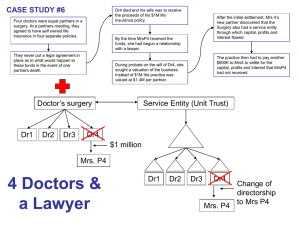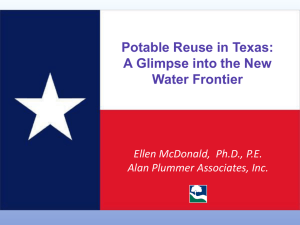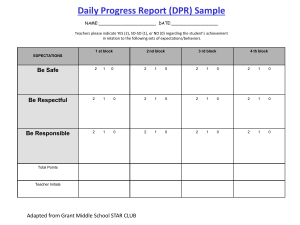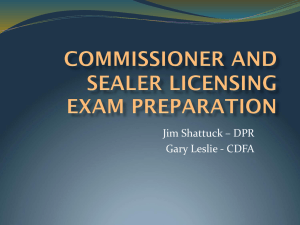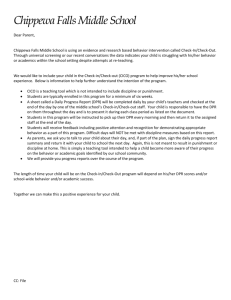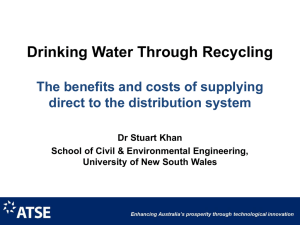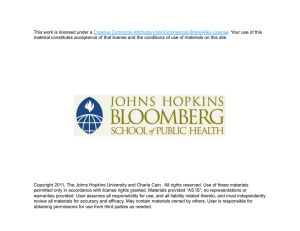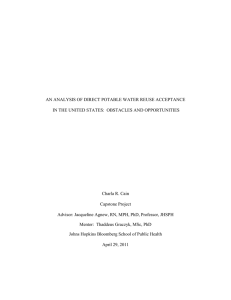Public Communication about DPR KEY THEMES TO GOOD COMM
advertisement
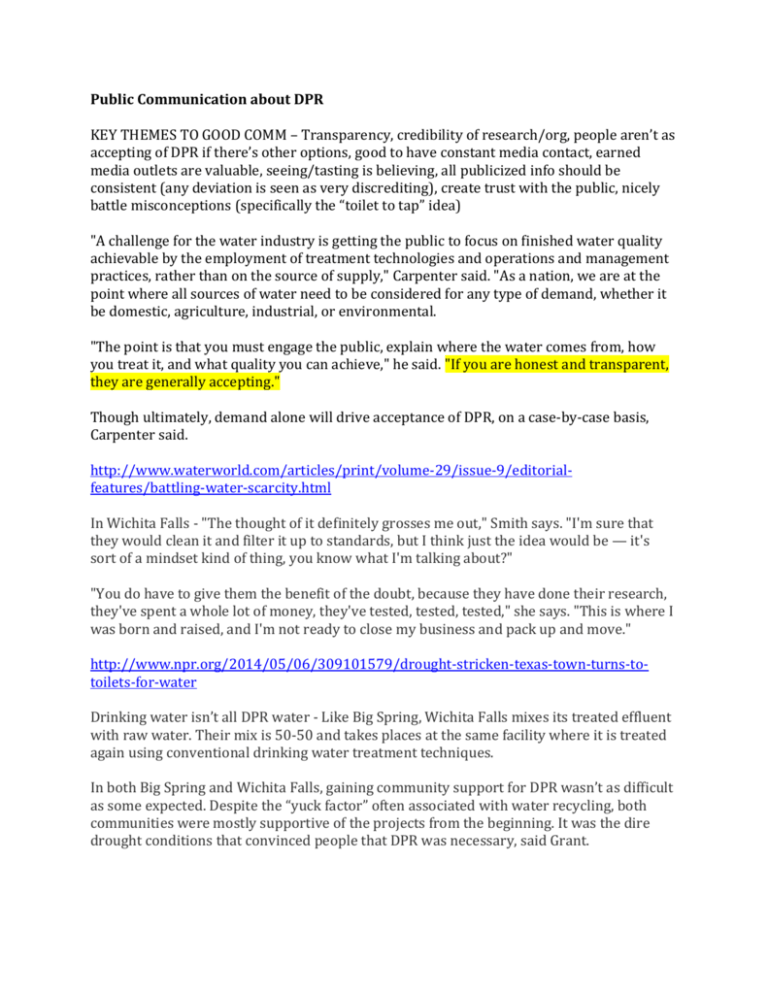
Public Communication about DPR KEY THEMES TO GOOD COMM – Transparency, credibility of research/org, people aren’t as accepting of DPR if there’s other options, good to have constant media contact, earned media outlets are valuable, seeing/tasting is believing, all publicized info should be consistent (any deviation is seen as very discrediting), create trust with the public, nicely battle misconceptions (specifically the “toilet to tap” idea) "A challenge for the water industry is getting the public to focus on finished water quality achievable by the employment of treatment technologies and operations and management practices, rather than on the source of supply," Carpenter said. "As a nation, we are at the point where all sources of water need to be considered for any type of demand, whether it be domestic, agriculture, industrial, or environmental. "The point is that you must engage the public, explain where the water comes from, how you treat it, and what quality you can achieve," he said. "If you are honest and transparent, they are generally accepting." Though ultimately, demand alone will drive acceptance of DPR, on a case-by-case basis, Carpenter said. http://www.waterworld.com/articles/print/volume-29/issue-9/editorialfeatures/battling-water-scarcity.html In Wichita Falls - "The thought of it definitely grosses me out," Smith says. "I'm sure that they would clean it and filter it up to standards, but I think just the idea would be — it's sort of a mindset kind of thing, you know what I'm talking about?" "You do have to give them the benefit of the doubt, because they have done their research, they've spent a whole lot of money, they've tested, tested, tested," she says. "This is where I was born and raised, and I'm not ready to close my business and pack up and move." http://www.npr.org/2014/05/06/309101579/drought-stricken-texas-town-turns-totoilets-for-water Drinking water isn’t all DPR water - Like Big Spring, Wichita Falls mixes its treated effluent with raw water. Their mix is 50-50 and takes places at the same facility where it is treated again using conventional drinking water treatment techniques. In both Big Spring and Wichita Falls, gaining community support for DPR wasn’t as difficult as some expected. Despite the “yuck factor” often associated with water recycling, both communities were mostly supportive of the projects from the beginning. It was the dire drought conditions that convinced people that DPR was necessary, said Grant. Big Spring - “We still had some who were concerned, but most people were OK with it once we provided them with information. We held public meetings, we did news releases, we did television and radio, and we went around to civic clubs and did talks.” Education was also key in Wichita Falls. They created a video about the DPR project, which features utility representatives, doctors, and experts from local universities talking about the disinfection process and the safety of drinking recycled water. “The video was met with quite a bit of success,” said Nix. “We brought the media into the fold very early, we told them every step of the way what we were doing, and they’ve been getting the word out. Since we brought this treatment plant online, the feedback has been that the water tastes better than the lake water we were working with before.” The city of Brownwood, Texas, has approved a DPR project with the TCEQ but has not started construction because of public backlash. El Paso, Texas, which has had an IPR aquifer recharge project for many years, has also approached the TCEQ about the possibility of moving to DPR. In California, multiple IPR plants are in operation, and there are significant efforts underway to better understand and form regulations around DPR applications. http://www.wateronline.com/doc/texas-leads-the-way-with-first-direct-potable-reusefacilities-in-u-s-0001 All of Watereuse’s research on DPR and communication isn’t free, but it’s all here. The article is called “Model Communication Plans for Increasing Awareness and Fostering Acceptance of Direct Potable Reuse” - https://www.watereuse.org/catalog/researchreports/potable-reuse Wichita Falls residents reported a better tasting product flowing from their faucets, and the Texas Commission on Environmental Quality in August confirmed that opinion by awarding the city’s drinking supply with its highest possible rating of Superior Public Water System. The city also announced the system had returned 1 billion gallons of water to the drinking system in February — a little over six months after the start date. “We knew there would be some lighthearted ribbing, which I believe we got from Fallon, but as larger media outlets like CNN, the Weather Channel, the Today Show, The New York Times — as well as our own — started doing more articles on it in a positive light ... it started getting more attention from other communities. In fact, we’ve spoken with California on several occasions about how we got public support for the DPR.” “They’re driven by other factors such as sustainability, just like what they’re doing in Singapore. In other areas, it’s wastewater disposal issues ... it’s not only drought that drives considerations into DPR. We learn about those considerations as well.” http://www.timesrecordnews.com/news/lifeline/praise-questsions-pour-into-city-for-dpr We’re drinking treated wastewater anyways - A recent study by the University of Arizona showed several drinking water treatment plants in the U.S. get their influent from water sources that, under low flow conditions, consist of 100 percent wastewater from upstream cities. In other words, the wastewater discharges from one city are not diluted at all by clean "natural" water when the next city takes it for their drinking water source. Even under average flow conditions, some drinking water plants use water containing more than 20 percent wastewater. Of the 11 drinking water plant intakes in the U.S. with the highest percentage of such de facto reuse, eight are in Texas. So, many Texans are now, probably unknown to them, ingesting water that was recently municipal wastewater. Yes, natural processes in those rivers help clean the water, but those processes are generally slow, so the natural cleanup is minimal when the travel time between cities is only days. Simply put, if you want to drink very clean water, direct potable reuse will likely provide higher quality water than many drinking water plants currently produce now. Why? Because those slow, natural river processes will be replaced by highly engineered, wellmonitored, advanced treatment processes that remove contaminants much better. http://news.utexas.edu/2014/08/01/what-every-texan-needs-to-know-about%E2%80%9Ctoilet-to-tap%E2%80%9D-water US public acceptance of water reuse seems to be higher when [2–5]: • Degree of human contact is minimal • Protection of public health is clear • Protection of the environment is a clear benefit of the reuse • Promotion of water conservation is a clear benefit of the reuse • Cost of treatment and distribution technologies and systems is reasonable • Perception of wastewater as the source of reclaimed water is minimal • Awareness of water supply problems in the community is high • Role of reclaimed water in overall water supply scheme is clear • Perception of the quality of reclaimed water is high • Confidence in local management of public utilities and technologies is high In other words, the “yuck factor,” the term that US water professionals have used to discuss the visceral reaction of displeasure and distain expressed by the public in regards to water reuse, may be tempered by an individual’s proximity to the waste source People generally favor reuse that promotes water conservation, provides environmental protection benefits, protects human health, and cost effectively treats and distributes a valuable and limited resource. However, as the water options become more tangible to people with specific proposed projects in their communities and the likelihood of human contact increasing, attitudes change — the public’s support wanes Furthermore, while the public has reported trusting university-based scientists and the medical community on technical and health issues related to water reuse, preliminary survey evidence showed people trust their own personal impressions of water quality (often based upon the water’s cloudiness or turbidity) more than these experts those that are opposed to water reuse became more strongly opposed and those that support it became more strongly supportive after becoming more knowledgeable and aware Information, knowledge, local context, and education all play an important role in shaping percep-tion and the nature of public participation…. Furthermore, the uncertainty or incompleteness of information in any of these information categories influences perception about water reuse Individuals need to be motivated to participate in water reuse decision-making. Rarely is a single motive enough; usually someone needs multiple motives to engage and stay involved. Organizational, too, must demonstrate a genuine commitment to public participation that contributes to trust-building and the perception of fairness Keeping participants motivated to sustain their involvement, and demonstrating clear organizational commitment to listening to people’s concerns and taking them seriously proved important in the cases While decisions needed to be technically and scientifically sound, they also needed to be perceived as fair. There were different strategies used to demonstrate a fair and sound process. For example, the City of San Antonio put forth criteria in guidance that specifically addressed fairness, trust and credibility in the process. It also took very public actions to implement those decision making criteria. “It is important the agency is committed to building the public’s trust by designing a public participation process that is fair, allows for two-way communication, solicits honest community feedback, and is willing to incorporate public input into the final program design.” Do the following: Manage information for all, Maintain individual motivation and demonstrate organizational commitment, Promote communication and public dialog, Ensure fair and sound decision-making and decisions, Build and maintain trust http://www.vims.edu/people/hartley_tw/pubs/Publicperceptionandparticipationinwater euse.pdf

